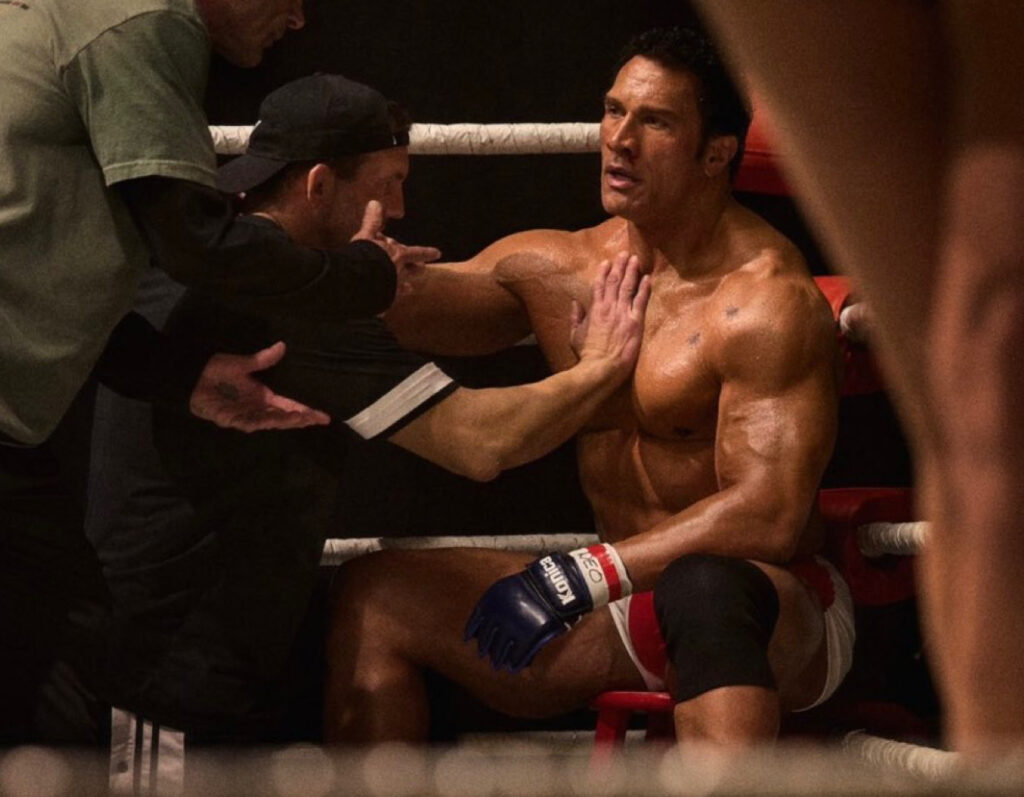In The Smashing Machine, Dwayne “The Rock” Johnson doesn’t so much abandon his polished superstar persona as he dismembers it, limb by limb, in a brutal reconstitution of self. Gone is the affable, smirking titan of Hollywood box office and branding empires. In his place emerges a broken, bleeding, fully submerged actor portraying the rise and near obliteration of real-life MMA pioneer Mark Kerr. Directed by Benny Safdie in his first solo feature since his collaboration with brother Josh on Uncut Gems, this film is not just a biopic—it is an elegy, a raw, hallucinatory descent into the agony of ambition and the architecture of pain.
Kerr, once dubbed “The Smashing Machine” for his pulverizing dominance in the early no-holds-barred era of mixed martial arts, is a figure shrouded in contradictions: a gentle juggernaut, a haunted winner, a man who craved the clean violence of the cage because life outside it was a labyrinth of unresolved trauma. In embodying Kerr, Johnson performs an exorcism of his own image, dismantling the mythologies of fame, masculinity, and invincibility that he himself helped codify.
This is Johnson’s Raging Bull, his Wrestler, his obliteration of the Fourth Wall between persona and performer. But unlike Jake LaMotta or Randy “The Ram” Robinson, Mark Kerr isn’t fictionalized into martyrdom. He’s real—and still alive. Which makes Johnson’s performance all the more treacherous and sacred.
From Titan to Tragedian: The Fall of the Rock
For years, Johnson has played variations of himself: larger-than-life heroes with gleaming teeth, sculpted arms, and hearts of gold. His blockbuster machinery—from Fast & Furious spinoffs to Jumanji reboots—cemented a brand more than a body of work. He was bulletproof, both figuratively and sometimes literally. But in The Smashing Machine, Johnson dissolves this armor. His body, once his calling card, becomes a site of suffering. His face is swollen, drugged, bloody. His voice slurs not with charisma, but with addiction and desperation. He isn’t playing a hero. He’s inhabiting a man slowly consumed by the very discipline that once defined him.
Johnson trained extensively to match Kerr’s physicality, but more astonishing is his psychological transformation. He plays Kerr not as a gladiator, but as a wounded child locked in a man’s frame. There are no triumphant arcs here. No underdog victories. No closing monologues about redemption. This is method, not spectacle. Performance, not projection.
In shedding the theatrics of his WWE past and the polish of his Hollywood reign, Johnson embraces something almost dangerous: the vulnerability of realism. It’s not a transformation for acclaim; it’s an invocation of deeper truths. He finds pain, and he sits in it. The audience, stunned, follows him there.
Safdie’s Vision: Chaos as Canvas
Benny Safdie directs The Smashing Machine with the same unrelenting tension that fueled Good Time and Uncut Gems, but this is not simply another anxiety opera. Here, the Safdie style serves as a psychological x-ray. The camera doesn’t just follow Kerr into fights—it pulses with his breath, shakes with his anxiety, blacks out with his comedowns. We are not watching a man fall apart—we are falling with him.
Safdie eschews the typical biopic arc for a chaotic, non-linear structure. Flashbacks bleed into hallucinations. Memories collapse into nightmares. Training montages are intercut with drug-fueled stupors and hospital visits. Johnson’s body is not sculpted—it’s punished, crucified across time. The film doesn’t ask us to admire Kerr’s strength. It dares us to witness his fragility.
Safdie’s MMA sequences are unflinching. The fights are not cinematic ballet—they’re wars of attrition. The camera gets inside the clinch, beneath the mount, beneath the skin. There is no glamor in the grappling. Only exhaustion. It feels as if the film itself is bruised, cut, limping by its final act.
Yet there is beauty in this suffering. Cinematographer Darius Khondji (if rumors prove true) shoots the film like a 1990s fever dream: neon reflections on hospital tiles, the strobe of club lights refracted through sweat, the shimmer of blood beneath fluorescent training rooms. It’s a world caught between mania and oblivion—a visual metaphor for Kerr’s psyche, and perhaps Johnson’s too.
Mark Kerr: The Man Beneath the Monolith
Kerr’s story, chronicled originally in the 2002 HBO documentary The Smashing Machine, is a Greek tragedy in tap-out form. A two-time NCAA wrestling champion and early UFC star, Kerr dominated the early Vale Tudo scene with brute power and suffocating control. But behind the accolades was a man unraveling. Addiction to opioids, steroids, and painkillers ravaged his body and psyche. Personal relationships withered. Fame suffocated him. Even victory felt hollow.
What makes Kerr’s story cinematic isn’t just the violence. It’s the contradiction. He wasn’t a killer—he was a people pleaser. He fought because it gave him order, a cage in which he could control chaos. Johnson captures this duality not through monologue, but through presence. The quiet scenes—Kerr failing to connect with his partner, zoning out in locker rooms, staring blankly at his bruised knuckles—are as crushing as any headkick.
And yet The Smashing Machine refuses pity. It never begs for our sympathy. Kerr’s journey is framed with honesty, not sentimentality. His pain is unadorned. His failures are not cathartic—they’re cumulative. By the end, we understand Kerr not as a tragic hero, but as a man who tried to survive the myth he became.
The Steroid Body in Crisis
One of the film’s most haunting themes is the grotesque legacy of steroid culture—particularly in 1990s and early 2000s MMA. The Smashing Machine doesn’t moralize about performance-enhancing drugs; it anatomizes them. Safdie presents Kerr’s body as a battleground between chemistry and consequence. Swollen muscles hide soft organs. Synthetic hormones mutate testosterone into a psychological pressure cooker. Every injection is a Faustian bargain.
Johnson, long critiqued for his own chiseled physique, confronts the steroid question head-on. He shows what happens when a body is built not for longevity but for dominance. The film’s close-ups of needle punctures, shrunken testicles, abscessed wounds, and roid rage aren’t exploitative—they’re tragic.
This is not just a narrative about fighting. It’s about the cost of optimization. The ruinous pursuit of an ideal body. The lie that stronger equals safer. The Smashing Machine obliterates the myth of “clean power” in sports. It doesn’t ask if the violence is worth it. It shows us that it isn’t—and never was.
Wrestling with Legacy: Johnson’s Own Smashing Mirror
Perhaps the most fascinating undercurrent in the film is the way Johnson’s own mythology echoes Kerr’s. Both men were wrestlers. Both sculpted bodies into brands. Both became commodities—Kerr to a ruthless MMA machine that chewed him up, and Johnson to a Hollywood system that rarely allowed depth beyond charisma.
But while Kerr was destroyed by that system, Johnson is now using it to reconstruct something richer. The Smashing Machine is as much an act of artistic liberation as it is performance. By choosing this role—and by performing it with such emotional nudity—Johnson breaks his own mold. He becomes not a reformed action star, but a legitimate actor of staggering risk.
If Black Adam was Johnson’s attempt at control, The Smashing Machine is his surrender. And it’s the most powerful thing he’s ever done.
A Biopic That Breaks the Bones of the Genre
Where many biopics celebrate legacy, The Smashing Machine questions whether legacy is survivable. It never falls into the trap of redemption arcs or final triumphs. There is no climactic comeback fight. No neatly resolved third act. There is only aftermath.
The film ends not with Kerr’s victory—but with his aloneness. The cage disappears. The cheers fade. There is only a man, his breath ragged, trying to remember who he is without someone else to beat.
And that is the triumph: the recognition that healing is not cinematic. It’s quiet. Ongoing. Incomplete.
Aftermath: An Earthquake in Hollywood
Already, The Smashing Machine is drawing comparisons to Foxcatcher, The Wrestler, and Raging Bull, but it’s more ruptural than referential. It arrives at a time when physicality in film is either sanitized (superhero films) or fetishized (fitness influencers as protagonists). Safdie and Johnson do neither. They depict the human body in revolt, collapsing under pressure—culturally, chemically, existentially.
There is already murmuring of awards potential, but to reduce this film to Oscar bait would be insulting. Johnson didn’t make The Smashing Machine to win gold. He made it to touch something mortal. To bruise the screen in the same way Kerr bruised the mat. To leave a mark that doesn’t heal.
This isn’t Dwayne Johnson’s comeback. It’s his combustion. And from those ashes, something shocking and real has emerged.
No comments yet.








